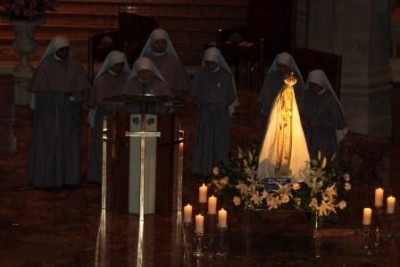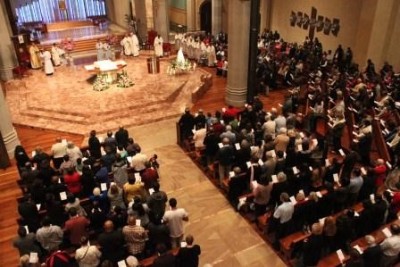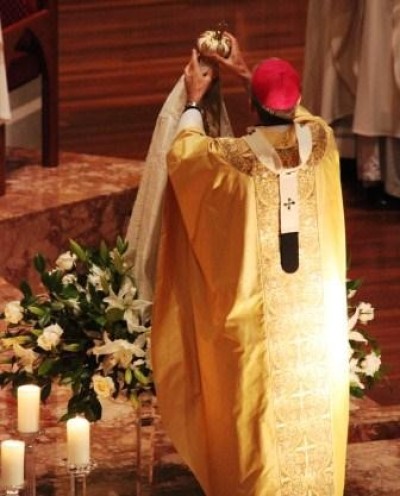Crowds Flock to Pilgrim Statue of Fatima
Large crowds flocked to St Mary's Cathedral on the Memorial of the Queenship of Mary on 22 August to celebrate Mass and pray before the pilgrim statue of Our Lady of Fatima to seek her intercession.

At an evening Mass, Archbishop Costelloe SDB, said that the crowded Cathedral exemplified the special place of honour the Blessed Virgin Mary held in the hearts of Catholics.

In his homily, the Archbishop reflected on how Vatican II saw the Blessed Virgin Mary as a person of faith and discipleship.
HOMILY OF

ARCHBISHOP TIMOTHY COSTELLOE SDB
On November 21, 1964, the Fathers of the Second Vatican Council formally promulgated the Dogmatic Constitution on the Church, which we know today as the document Lumen Gentium.
It is a very beautiful and rich document which sets out for us the Church’s self-understanding. It talks about the Church as the Sacrament, the living and effective sign of salvation and in doing so reminds us that every single one of us, simply because we are baptized, is called to a life of holiness and to the mission of sharing the Good News of salvation with others. Faith, in other words, is not a gift given to us to be jealously hoarded but rather a gift which we are called to share, not as Pope Francis would say by imposing, but rather by ceaselessly proposing the joy of following Christ.
Among the many beautiful things found in the document Lumen Gentium we find a very important explanation of the role of the Blessed Virgin Mary in the life of the Church. In fact the document concludes with this reflection on Mary. It is important for us to realize that it was a very deliberate decision on the part of the bishops to include Mary in the document on the Church rather than to have a separate document dealing exclusively with her. As many of you would know the Second Vatican Council produced a significant number of documents. There is one on the Church, one on the bishops, one on the priesthood, one on the religious life, one of the ecumenical movement , one on the liturgy, and so on. The bishops could easily have decided to have had one on the Blessed Virgin as well but, guided by the Holy Spirit, they decided that a reflection on Mary only really makes sense if it is part of a reflection on the very nature of the Church itself. This should not surprise us, because it was the Lord himself who gave Mary to the Church and gave the Church to Mary when, as he was dying on the cross, he entrusted Mary to the beloved disciple and entrusted the beloved disciple to Mary.
This was not simply an act of filial care by which Jesus wished to make sure that Mary would be cared for after his death. It was in fact a key moment when the Lord revealed to us the true nature of his Church. In the New Testament, Mary is constantly presented to us as the great woman of faith. It was her faith which allowed her to say “yes” to God’s plan that she become the mother of the savior. It was her faith which enabled her to be a faithful follower of her Son throughout her life. It was her faith which led her to ask Jesus to do something for the bride and groom who had run out of wine at their wedding feast. And of course it was her faith which enabled her to stand with such courage at the foot of the cross and watch her Son die, uniting herself with his gift of himself for the life of the world. Mary stands at the heart of the gospel tradition as the great woman of faith, and in this she becomes both our model and our inspiration. The Church is called to be a community of faith. Mary shows us what this means.
The beloved disciple, to whom Jesus entrusts Mary from the cross and whom we know as Saint John, is called the beloved disciple for a reason. He stands in the gospel tradition, and especially in the Gospel of Saint John, as the great example, the great model of discipleship. When all the other disciples desert Jesus, the beloved disciple remains faithful. While all the others are running away in fear he stays at the foot of the cross. And it is to him that Jesus entrusts Mary just as it is to Mary that Jesus entrusts the beloved disciple. What this really means is that Mary, the great woman of faith, and Saint John, the great man of discipleship, symbolize and represent together the Church as it is called to be, steadfast in faith, constant in discipleship, and courageous in remaining at the foot of the cross, never running away from the call to keep on following Jesus no matter what the cost.
As the great woman of faith, of course, Mary always remains for the Church what she is for Jesus: his and our mother. If the Church is, as Saint Paul tells us, the Body of Christ, then Mary, who is the Mother of Christ, is also the mother of his body the Church.
As the document Lumen Gentium expresses it:
Mary conceived, brought forth and nourished Christ. She presented Him to the Father in the temple, and was united with Him by compassion as He died on the Cross. In this unique way she cooperated by her obedience, faith, hope and burning love in the work of the Saviour in giving back supernatural life to souls. Therefore she is our mother in the order of grace.
And then the Fathers of the Council go on to say this:
This motherhood of Mary in the order of grace began with the consent which she gave in faith at the Annunciation and which she sustained without wavering beneath the cross, and it lasts until the eternal fulfillment of all the elect. Taken up to heaven she did not lay aside this salvific duty, but by her constant intercession continued to bring us the gifts of eternal salvation.
In saying this the bishops at the Council brought together the two great roles which Mary plays in our life and in the life of the Church. As the great woman of faith, Mary is our model and our inspiration. But as the one who has been assumed into heaven body and soul, and as the one whose mind and heart are so closely attuned to the mind and heart of Christ, Mary is also our helper, our supporter and our advocate with the Father. As we so often express in the greatest of Marian prayers, the Hail Mary, she is the one who prays for us now and at the hour of our death. This is the way in which she gives expression to her role as Queen, the title we remember in today’s liturgy, and it is the way in which the apparitions of Mary at Fatima also portray her. She accompanies us through our lives of faith as our great model and as our mother and helper.
Let us continue to turn to her each day, constantly asking her to pray for us as our Catholic tradition teaches us and encourages us to do. And let us allow ourselves to hear her say to us, as she said to the stewards in charge of the wine at the wedding feast at Cana, “You do whatever he, Jesus, tells you.”
